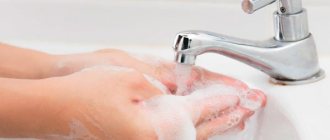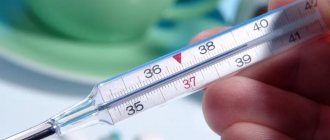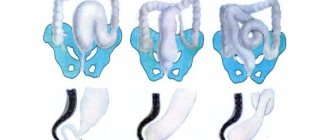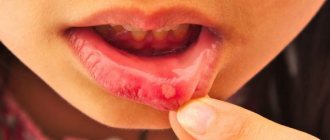Description of the disease
Balanoposthitis is a common problem in pediatric practice.
Almost every boy has encountered this disease. It manifests itself as simultaneous inflammation of the foreskin and head of the penis. Most often, pathology develops when the rules of hygiene of the intimate area are violated. Therefore, statistically, the disease occurs mainly under the age of 12-14 years. The local inflammatory process does not pose a direct threat to the child’s health. However, the danger lies in the complications that arise against the background of the transition of an acute process to a chronic one. In the absence of targeted and timely treatment, adhesions form between the foreskin and the glans penis - phimosis develops. Sometimes the disease causes deformation of the head of the penis, which creates psychological discomfort for a man in adulthood and can worsen the quality of sexual life.
Depending on the clinical manifestations, balanoposthitis in children is divided into 3 forms:
- Catarrhal. This variant of the disease occurs in 70-80% of cases. It is characterized by moderate severity of symptoms and responds well to treatment.
- Erosive. A more severe form of the disease. Tissue defects form on the head of the penis. Infection penetrates into these areas more easily, causing the development of complications.
- Gangrenous. A particularly severe form of the disease, which is characterized by a sharp deterioration in the child’s condition. Due to the massive penetration of bacteria, partial necrosis of the penile tissue occurs.
Balanoposthitis can occur acutely or chronically. The first option is more favorable, since it can be cured fairly quickly. The main thing is not to delay visiting a doctor if characteristic symptoms of the disease are detected.
Types of disease
Due to their occurrence, the following types of urethritis are distinguished:
1. Infectious. Occurs as a result of exposure to pathogenic and opportunistic microflora:
- nonspecific - caused by Escherichia coli, staphylococci, streptococci;
- specific - caused by specific pathogens (chlamydia, gonococci, Trichomonas and others).
2. Non-infectious. Occurs as a result of allergic reactions, injuries to the urethra.
Based on the type of pathogen, the following types of urethritis are distinguished:
- gonorrheal (caused by gonococcus);
- non-gonorrheal (causative agents are viruses, bacteria, protozoa, fungi of the genus Candida).
According to the localization of inflammation, urethritis is:
- posterior (the back of the urethra is affected);
- anterior (the anterior part of the urethra is affected);
- total (the entire urethra is affected).
According to the mechanism of development, the following types of disease are distinguished:
- primary urethritis - inflammation begins in the urethra;
- secondary urethritis - the infection enters the urethra from another source of inflammation, which can be located in the bladder, head of the penis, vagina, or prostate gland.
According to the clinical course, urethritis can be acute (up to 14 days) and chronic (14 days or more). The chronic form of the disease usually develops in the absence of timely therapy.
Symptoms of balanoposthitis in children
The clinical picture of the disease is caused by the formation of a local focus of inflammation in the penile area. The severity of symptoms depends on the form of balanoposthitis, the severity of the episode of the disease and the individual characteristics of the boy’s body. The main clinical signs of the acute form of balanoposthitis in childhood are:
- redness of the foreskin area;
- swelling of the tissue around the head of the penis;
- itching and pain that intensifies when touching the penis or urinating;
- moodiness, sleep disturbance, which are the result of constant discomfort;
- enlarged inguinal lymph nodes;
- increase in body temperature to 38-39°C.
It is worth noting that in 80% of cases the child’s general condition changes little.
He continues to play actively and eats normally. The severity of fever can vary depending on the intensity of the body's defenses and the activity of the inflammatory process. The chronic form of balanoposthitis is characterized by alternating episodes of exacerbation and remission. Discomfort in the area of the head of the penis, swelling and redness are not so pronounced. White discharge forms in the area of the preputial sac, which is a favorable environment for the development of bacteria with the subsequent formation of adhesions.
How to understand that a child has balanoposthitis?
The inflammation itself—redness and swelling, often discharge—is usually visible to the naked eye. Cracks or diaper rash may appear on the skin. Inflammation may also be accompanied by general intoxication of the body, which manifests itself in chills, fever, enlarged inguinal lymph nodes, disturbances in appetite and sleep (general intoxication is quite rare; as a rule, children outside the toilet continue to lead a normal life). In addition, it is painful, so the baby may cry when urinating or be afraid to go to the toilet. If any of these symptoms occur, you should make an appointment with a pediatric surgeon (urologist) as soon as possible.
Causes of balanoposthitis in children
The pathogenetic basis of balanoposthitis is local inflammation provoked by the penetration of bacteria.
These are staphylococci, streptococci, E. coli. These microorganisms trigger a cascade of biochemical reactions that are responsible for the development of the characteristic clinical picture. The reasons for the penetration of pathogens into the area of the preputial sac are:
- Long-term wearing of diapers in newborns and infants without replacement. Due to the accumulation of urine, favorable conditions arise for the development of bacteria in the prepuce area.
- Insufficient genital hygiene in preschool and adolescence. It is important to explain to boys that when taking a shower or bath they need to retract the foreskin and wash the area of the preputial sac. Otherwise, the natural secretion of the glands stagnates in this area, which over time also becomes a breeding ground for bacteria.
- Traumatic injuries. If the integrity of the skin in the foreskin area is damaged and insufficiently treated with antiseptics, bacteria and fungi can penetrate there.
- Wearing underwear that is too tight. Impaired microcirculation causes a decrease in local immunity.
- Allergy to washing powder or certain foods. The developing immune imbalance creates conditions for injury to the skin and mucous membranes with subsequent penetration of pathogens.
Some authors indicate a connection between balanoposthitis and frequent masturbation in boys during adolescence.
Causes
The cause of inflammation of the head of the penis can be infectious or non-infectious. One of the main non-infectious causes is poor hygiene of the genital organs, as a result of which secretions begin to accumulate under the foreskin, which causes an inflammatory process. Other causes of inflammation of the head of the penis include:
- infectious and inflammatory diseases of the genitourinary system (urethritis, cystitis);
- skin diseases (psoriasis, dermatitis);
- narrowing of the foreskin (phimosis);
- trauma to the skin of the penis (burns, scratches);
- allergic reactions to hygiene products, underwear or contraceptives.
A common cause of inflammation of the glans penis in a child is uncomfortable underwear. It causes discomfort, rubs and injures the skin, causing balanitis in boys.
Expert opinion
Balanoposthitis in children is a common problem in pediatrics. The disease is not dangerous and does not threaten the child’s health. However, if clinical signs are ignored, banal discomfort in the groin area can cause serious problems for a boy in adulthood. Therefore, it is recommended to seek help from a specialist if you notice redness and itching in the foreskin area. The use of traditional medicine methods without prior consultation with a doctor can contribute to the transition of an acute form of the disease to a chronic one. In the future, this condition is an indication for surgical intervention, so it is better not to self-medicate.
Diagnostics
At the first appointment, the urologist collects anamnesis, finds out what the patient is complaining about, and determines possible provoking factors. Next, the doctor conducts a physical examination, which includes palpation of the lower back, abdomen, and examination of the external opening of the urethra.
For a more accurate diagnosis of the disease, the following laboratory and instrumental research methods are used:
- Ultrasound of the kidneys and bladder . This is a basic diagnostic method. Using ultrasound, congenital abnormalities of the urinary system organs are diagnosed, which could lead to inflammation of the urethra. If the inflammatory process is strong, then on ultrasound you can see thickening of the urethral wall, but such data are not always informative.
- Urine tests . With inflammation of the urethra, the following laboratory symptoms are observed: sediment, turbidity, and a shift in pH to the alkaline side. To confirm the presence of inflammation in the urethra, a urine test according to Nechiporenko is prescribed. To establish the exact location of the source of inflammation, a three-glass test is indicated.
- Cystoureterography. It is usually prescribed to babies under one year of age with signs of chronic urethritis for differential diagnosis of vesicoureteral reflux. If the doctor suspects congenital malformations of the urinary system, excretory urography is additionally prescribed. Important! All diagnostic procedures must be performed strictly in the remission phase.
- Microbiological diagnostic methods . To determine the type of pathogen, urine culture, bacteriological and microscopic examination of smears from the urethra are carried out. To diagnose specific infections, PCR and ELISA studies are carried out. To correctly prescribe treatment, a test for antibiotic resistance is indicated.
Based on the clinical symptoms of urethritis in a child, data from laboratory and instrumental studies, the doctor prescribes a course of treatment.
Diagnosis of balanoposthitis in children
Diagnosis of balanoposthitis in children is based on an analysis of the patient’s complaints, collection of anamnesis and examination of the pathological area.
In 95% of cases, the urologist correctly determines the cause of the characteristic symptoms at the first consultation. To confirm the diagnosis and exclude other possible diseases, the doctor prescribes a comprehensive examination:
- general blood analysis;
- blood chemistry;
- general urine analysis;
- bacteriological examination of discharge from the preputial sac;
- blood test for infections (HIV, syphilis, viral hepatitis B, C).
If necessary, the child is examined by related specialists (pediatrician, ophthalmologist, gastroenterologist) to exclude somatic diseases.
Preparations for topical use
- Antibacterial agents: chloramphenicol (Syntomycin); sulfonamide (Streptocide ointment), tetracycline (Tetracycline ointment), metronidazole (Rozamet)
- Antiseptics: miramistin, chlorhexidine.
- Anti-inflammatory drugs with antipruritic effect: triamcinolone (Fluorocort)
- Agents for tissue regeneration and wound healing: chloramphenicol (Levomekol), dexpanthenol (Bepanten, Pantestin).
- Antimicrobial and antifungal: fluconazole (Flucorem); clotrimazole (Clotrimazole), omoconazole nitrate (Mycogal).
Treatment of balanoposthitis in children
The acute form of balanoposthitis is a disease that is relatively easy to treat conservatively. However, when it becomes chronic and involves the formation of adhesions between the head of the penis and the foreskin, surgical intervention may be necessary.
Conservative treatment
The essence of therapy is to suppress the focus of local inflammation and destroy pathogenic microorganisms. For this purpose, the pediatric urologist prescribes:
- antibacterial ointments that are injected into the preputial sac;
- baths with antiseptics - a light solution of potassium permanganate, chamomile, furatsilin;
- vitamin preparations to strengthen the immune system;
- antipyretic medications for fever.
In 70-85% of cases of catarrhal forms of balanoposthitis, it is possible to eliminate symptoms with the help of such therapy within 2-3 days. The doctor teaches the child and parents the rules of caring for the genitals and points out the importance of choosing loose underwear. For erosive and gangrenous forms of the disease, healing ointments, systemic antibiotics and detoxifying solutions are additionally prescribed. The selection of medications is carried out individually depending on the characteristics of the clinical case.
Surgery
In the chronic form of balanoposthitis, dense cords (adhesions) form between the tissues of the penis and foreskin, which make the release of the head impossible.
Conservative therapy does not help in this case. To eliminate the problem, the patient is recommended to undergo circumcision of the foreskin. The operation promotes complete release of the glans penis and is the optimal method for preventing future relapses. If the foreskin is excised, the risk of bacteria accumulating in the prepuce area is eliminated. The intervention is performed under general anesthesia. The duration of the procedure is up to 30 minutes. Postoperative recovery takes 1-2 weeks.
How is balanoposthitis treated?
Usually, with such inflammation, a pediatric surgeon (urologist) prescribes conservative local treatment. Opening the head is carried out only if it is necessary to remove pus, and in all other cases it is not recommended. To treat the inflamed area, antiseptics, soothing herbs in the form of baths (chamomile, chamomile), and antibacterial ointments, for example, levomikol, are used. If a fungal infection occurs, antifungal agents are used. To relieve swelling, the child may be prescribed antihistamines. The prognosis is favorable: the disease can usually be cured within a few days.
Questions
- Which doctor treats balanoposthitis in children?
Diagnostics and medical care for balanoposthitis is provided by a pediatric urologist. - Is surgery necessary for balanoposthitis?
In 90% of cases, the disease can be managed with conservative therapy. The exception is chronic forms, when adhesions form between the head of the penis and the foreskin with the development of phimosis. In this case, circumcision is indicated. - Do folk remedies help with balanoposthitis in children?
Various decoctions of plants with an antiseptic effect can be used as baths for inflammation of the foreskin and glans penis. However, this approach is justified only after the child has been examined by a doctor. Otherwise, parents may miss the moment of active progression of the disease and allow it to become chronic and develop complications. - Is circumcision beneficial for balanoposthitis?
Sometimes, with frequent episodes of acute balanoposthitis, pediatric urologists recommend circumcision to prevent relapses of the disease. This removes the preputial sac, which is a container for the secretions of the glands in the area of the head of the penis. With the help of planned intervention, the risk of recurrent inflammation can be permanently eliminated. However, the choice in this case remains with the patient and parents.
Treatment
After receiving and analyzing the diagnostic results, the urologist determines how to cure balanitis and relieve inflammation of the head. Treatment of balanitis begins with strict adherence to personal hygiene. It is necessary to wash the penis with soap several times a day. By adhering to this rule in the early stages of the disease, you can stop the pathological process of inflammation of the head of the penis and avoid other types of treatment.
For more serious forms of inflammation of the head in men, drug treatment is prescribed. Medicines for balanitis have an antiseptic effect. Most often, inflammation of the glans penis is treated with ointments or creams.
In addition to ointments, the doctor can also prescribe drug therapy: tablets for the treatment of balanitis in men, for example, Suprax, Azithromycin.
In rare and complicated cases, surgical treatment is used - excision of the foreskin.








